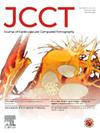Prognostic value of systolic left ventricular ejection fraction using prospective ECG-triggered cardiac CT
IF 5.5
2区 医学
Q1 CARDIAC & CARDIOVASCULAR SYSTEMS
引用次数: 0
Abstract
Background
Prospective ECG-triggered cardiac computed tomography (CT) imaging limits the ability to assess left ventricular (LV) ejection fraction (EF). We previously developed a new index derived from LV volume changes over 100 ms during systole (LVEF100msec) as a surrogate of LV function in patients undergoing prospective ECG-triggered cardiac CT. We sought to evaluate the prognostic value of LVEF100msec.
Methods
Patients undergoing prospective systolic ECG-triggered cardiac CT were enrolled between January 2015 and September 2022. Each CT was analyzed for LVEF100msec. Area under the curve analysis and Cox proportional hazards models were used to define the best LVEF100msec cut-off and to predict major adverse cardiovascular events (MACE), defined as a composite of all-cause death, cardiac death/arrest, non-fatal myocardial infarction, and stroke.
Results
The study enrolled 313 patients (median age = 58 years, male = 52.4 %). During a median follow-up of 924 (660–1365) days, 24 (7.7 %) patients had MACE. LVEF100msec was significantly lower in the MACE group compared to the non-MACE group (4.8 % vs. 8.3 %, p = 0.002). Optimal LVEF100msec cut-off for predicting MACE was 6.3 %. MACE-free survival rate was significantly lower in patients with LVEF100msec ≤6.3 % than those with >6.3 % (p < 0.001). LVEF100msec ≤6.3 % was an independent predictor of MACE, with an adjusted hazard ratio of 3.758 (95 % CI, 1.543–9.148; p = 0.004). The prognostic value of LVEF100msec was consistent across the various severities of coronary artery disease.
Conclusion
LVEF100msec was an independent predictor of adverse events. The implementation of LVEF100msec may improve the prognostic value of prospective ECG-triggered cardiac CT.
利用前瞻性心电图触发的心脏 CT 预测收缩期左心室射血分数的价值。
背景:前瞻性心电图触发的心脏计算机断层扫描(CT)成像限制了评估左心室射血分数(EF)的能力。我们之前开发了一种新的指数,该指数来源于收缩期 100 毫秒内左心室容积的变化(LVEF100msec),作为接受前瞻性心电图触发心脏 CT 患者左心室功能的替代指标。我们试图评估 LVEF100msec 的预后价值:2015年1月至2022年9月期间,接受前瞻性收缩期心电图触发心脏CT检查的患者入组。每次 CT 都对 LVEF100msec 进行分析。采用曲线下面积分析和Cox比例危险模型来确定最佳LVEF100msec临界值,并预测主要不良心血管事件(MACE),MACE定义为全因死亡、心源性死亡/休克、非致死性心肌梗死和卒中的综合:研究共招募了 313 名患者(中位年龄为 58 岁,男性占 52.4%)。在924(660-1365)天的中位随访期间,24(7.7%)名患者发生了MACE。与无并发症组相比,并发症组的 LVEF100msec 明显较低(4.8% 对 8.3%,P = 0.002)。预测MACE的最佳LVEF100msec临界值为6.3%。LVEF100msec≤6.3%的患者无MACE生存率明显低于LVEF100msec>6.3%的患者(P 100msec≤6.3%是MACE的独立预测因子,调整后危险比为3.758(95% CI,1.543-9.148;P = 0.004)。LVEF100msec的预后价值在不同严重程度的冠状动脉疾病中是一致的:结论:LVEF100msec是不良事件的独立预测因子。结论:LVEF100msec 是不良事件的独立预测因子,使用 LVEF100msec 可提高前瞻性心电图触发的心脏 CT 的预后价值。
本文章由计算机程序翻译,如有差异,请以英文原文为准。
求助全文
约1分钟内获得全文
求助全文
来源期刊

Journal of Cardiovascular Computed Tomography
CARDIAC & CARDIOVASCULAR SYSTEMS-RADIOLOGY, NUCLEAR MEDICINE & MEDICAL IMAGING
CiteScore
7.50
自引率
14.80%
发文量
212
审稿时长
40 days
期刊介绍:
The Journal of Cardiovascular Computed Tomography is a unique peer-review journal that integrates the entire international cardiovascular CT community including cardiologist and radiologists, from basic to clinical academic researchers, to private practitioners, engineers, allied professionals, industry, and trainees, all of whom are vital and interdependent members of our cardiovascular imaging community across the world. The goal of the journal is to advance the field of cardiovascular CT as the leading cardiovascular CT journal, attracting seminal work in the field with rapid and timely dissemination in electronic and print media.
 求助内容:
求助内容: 应助结果提醒方式:
应助结果提醒方式:


